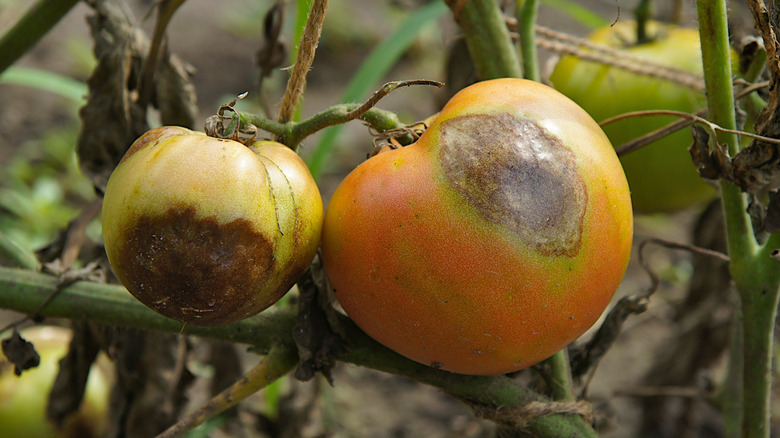Don't Confuse This Tomato Plant Disease For Blight
There is something wonderful about fresh, homegrown tomatoes. They always taste so much better than those bought at the store, and they have this delicious smell to them. So, it is always hard to see the tomato plants you have tended to for months have issues. There are quite a few common diseases and problems with garden tomatoes, and knowing how to identify and treat them helps you save what you can from the plants you have worked so hard to grow. One tomato plant disease that often gets confused with late blight is buckeye rot. Like blight, buckeye rot creates lesions on the fruits. They will first appear as small, brownish spots that then grow bigger into darker, circular rings. They are also both triggered by wet, poorly drained soils. Figuring out if your tomato plants have blight or buckeye allows you to treat them correctly.
To determine what is affecting your plant, take a closer look at the fruit. The lesions of buckeye rot will be smooth, whereas when the plant has late blight, the lesions will be rough and sunken. You should also have a look at the rest of the plant. Late blight affects the whole of the plant, with the leaves, fruit, and stems presenting with spots and markings. In contrast, buckeye rot will only appear on the fruit.
How to treat buckeye rot in tomatoes
If your tomato plants are blight-free and the cause of the issue is buckeye rot, you can treat your crops with fungicide to reduce the spread. Use sprays with chlorothalonil, mancozeb, or copper fungicides, applying them according to the manufacturer's instructions. As buckeye rot is soilborne and spreads with surface water and rain, keeping your fruit above the soil can prevent more of them from being infected. You can stake your plants to help them avoid contact with the soil and apply a layer of mulch. Ensuring that you pick the fruit as soon as it is ripe is also advisable.
As the oospores caused by buckeye rot are able to survive in the soil for years, there are things you can do to prevent it from affecting your plants in the future. Rotating your crops every season can reduce the risk of buckeye rot affecting your next load of tomatoes. Furthermore, ensure that you are planting your tomatoes in well-draining soil. Transitioning to raised beds can be useful to avoid buckeye rot coming back. There are also disease-resistant tomato varieties that you may want to consider planting, which can help lower the risk of issues next season.

